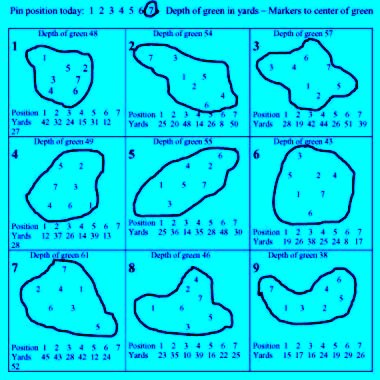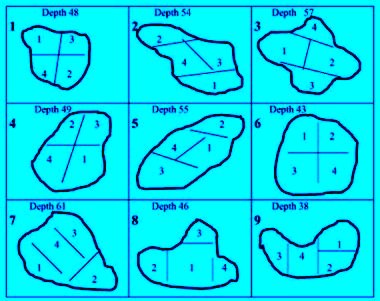Parts of the Golf Course:
Pin Position
In the early stages of learning to play the game of golf, the pin position – the place where the hole for the flag is put on the green – may not be your biggest worry because you don’t have the exact shots… yet.
But as your game improves, you want to start working out distances to the green and the club you need to hit to get there.
And while you’re still developing your shots, you’ll at least impress your playing partners at the next corporate golf outing by being able to read the pin sheet (a diagram that indicates where the flag is located on each hole).
During tournaments over multiple days, the pin position on all holes changes every day. At your local course, the holes are more likely to stay the same for several days, depending on the number of players passing through and the wear and tear caused to the grass.
The holes will be cut in a different part of the green, while the previous hole is filled in, giving that area the chance to heal itself.
Golf courses use different methods to indicate the location of the hole:
- Colored flags: the color of the flag attached to the pin indicates how far back on the green the hole has been cut.
For example, a white flag means it’s in the front part of the green, a red flag for the center of the green and a blue flag for the back portion of the green. The colors used and the position they represent will be listed on the score card.
- Pin sheets: show a diagram of each hole with either
- multiple positions shown on each hole, represented by numbers which correspond with the “position of the day”-number;
- or “segmented” greens, showing the part of the green where the flag stick is.


The distance from tee to green as given on a score card will vary according to the pin position. You need to work out how much shorter or longer the hole plays. Usually, yardages are given to the center of the green, although sometimes it is to the front of the green. A little adding or subtracting to account for the hole position’s variance from the score card or markers on the course will give you the right distance.
Using the illustration above, let’s look at a practical example.
- Imagine your ball is in the fairway next to the 100-yard marker on hole 2. This means that you have 100 yards left to the center of the green.
- According to the pin sheet, this green is 54 paces deep. That means that the center of that green - to where you have 100 yards to go - is at 27 paces (half the distance of the entire green).
- Today’s pin locations are position 7. On hole 2, position 7 is at 50 yards. This is 23 yards past the center of the green (at 27 yards) and therefore 23 yards further than the 100 yards from the marker where your ball is to the center of the green.
- The exact distance from the 100-yard marker to the flag stick is therefore not 100 but 123 yards!
Return from Pin Position to Courses
Return from Pin Position to Golf-Basics-for-Women
|